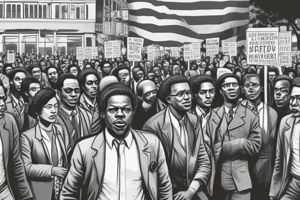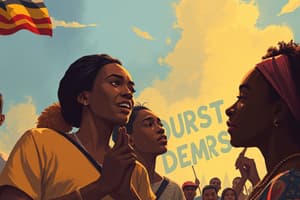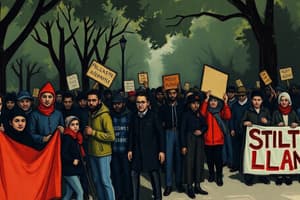Podcast
Questions and Answers
What was the primary aim of the civil rights movement?
What was the primary aim of the civil rights movement?
The movie 'Green Book' illustrates the ease of travel for African Americans in the segregated Southern United States.
The movie 'Green Book' illustrates the ease of travel for African Americans in the segregated Southern United States.
False (B)
Name one major legislative victory achieved during the civil rights movement.
Name one major legislative victory achieved during the civil rights movement.
Civil Rights Act of 1964 or Voting Rights Act of 1965
The civil rights movement and 'Green Book' underscore the power of _____ in combating social prejudice.
The civil rights movement and 'Green Book' underscore the power of _____ in combating social prejudice.
Signup and view all the answers
Match the following figures with their contributions to the civil rights movement:
Match the following figures with their contributions to the civil rights movement:
Signup and view all the answers
In 'Green Book', the relationship between Dr. Don Shirley and Tony Lip represents:
In 'Green Book', the relationship between Dr. Don Shirley and Tony Lip represents:
Signup and view all the answers
The civil rights movement was solely focused on legal reforms.
The civil rights movement was solely focused on legal reforms.
Signup and view all the answers
What does both the civil rights movement and 'Green Book' emphasize about social change?
What does both the civil rights movement and 'Green Book' emphasize about social change?
Signup and view all the answers
Study Notes
Civil Rights Movement and "Greenbook"
- Civil rights movement was a period of intense resistance against racial segregation and discrimination.
- Activists used nonviolent protests, legal challenges, and community organizing to combat unjust practices.
- Key figures like Martin Luther King Jr. and Rosa Parks led efforts to challenge these systems and achieve legislative victories, such as the Civil Rights Act of 1964 and the Voting Rights Act of 1965.
"Greenbook" and Racial Tension
- "Greenbook" depicts the journey of African American pianist Dr. Don Shirley and his Italian American driver Tony Lip through the American South.
- The film portrays the everyday struggles and dangers faced by African Americans due to racial barriers.
- The film highlights the indignities and obstacles encountered by African American travelers during racial segregation.
- It parallels the broader civil rights movement's challenges through a personal story of friendship.
Individual and Collective Action
- Both movements highlight the importance of individual and collective action against racism.
- Systematic change requires coordinated efforts, while personal relationships can bridge racial divides.
- Empathy, respect, and human connection play a crucial role in combating ingrained prejudices.
Overarching Themes
- Both the civil rights movement and "Greenbook" provide unique but complementary perspectives on America's racial history.
- They highlight the ongoing pursuit of racial equality and emphasize the need for continuous effort, understanding, and commitment to justice.
Studying That Suits You
Use AI to generate personalized quizzes and flashcards to suit your learning preferences.
Description
Explore the civil rights movement's impact on society and its key figures through the lens of the film 'Greenbook'. This quiz will test your knowledge of the struggles faced by African Americans and the historical milestones achieved during this pivotal era. Discover how personal stories intersect with broader social issues and movements.




